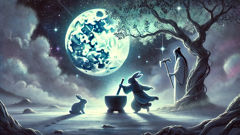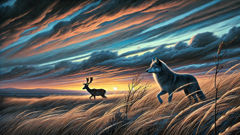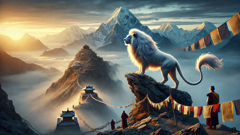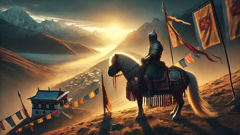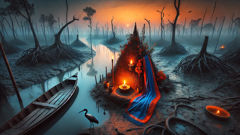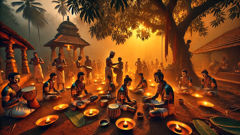Introduction
Along the ribboned banks of a river that braided through emerald rice paddies and low, fog-silvered hills, a village learned to listen to the world as if it were a neighbor speaking in low, patient tones. In that place, the sky and the water and the weather were not indifferent backdrops; they were living forces whose favor could be courted or whose anger could be warded off. The elders told their children that long before the tiled roofs and the lacquered boats, before the communal house stood on its pillars and the boats tied to bamboos bore the day’s catch, the land itself had been woven from a different kind of memory. In those old days, the people were visited by four beings that carried a quieter kind of thunder: a Dragon of river-mist and thunder, a Phoenix that rose from incense smoke and dawn, a Qilin whose hooves did not bruise the earth, and a Tortoise whose shell held the map of seasons. Each came bearing the essence of protection, fortune, and balance, and each left a signature upon the village—a ritual, a carving, a vow. The elders said that these creatures did not belong to any one household or to a single ruler; they belonged to the land’s sense of justice and the people's capacity to honor generosity, humility, and courage. Over years the tale took root like rice in a flooded field, growing into ceremonies timed with the moon, songs hummed while planting seedlings, and the careful placing of incense at shrine and threshold. To hear the story properly, one should imagine the scent of wet soil after rain, the silver throat of a river under sunrise, and the low clapping of bamboo against boat hulls at dusk. These are the textures of the legend—the world as it was felt, not merely seen—and in feeling it, the villagers learned how to walk with the auspicious animals rather than beneath them. The story that follows gathers natural detail and human tenderness, weaving myth and memory into a living map of how the Dragon, Phoenix, Qilin, and Tortoise came to guard a simple riverside people, how they shaped festivals and laws of kindness, and how their presence became a promise: that protection is earned, fortune is shared, and the world responds when gratitude is offered with an open hand.
Origins: River Dragon and Dawn Phoenix
The oldest songs in the village were songs of water. Children learned letters of sky and flood before they learned sums, and the first lessons of adulthood were couched in saving boats and reading the color of the clouds. It’s no wonder, then, that the first of the four auspicious animals to enter their shared memory was the Dragon. Not the grotesque, malevolent beast of a fearful tale, but a creature of braided elements: a spine of cloud, scales like river-silt, whiskers made from wind, and eyes where lightning slept. The elders said the Dragon was born each season of the heavy rains, when the river rose to meet the fields and the fish grew thick against green stems. It came in a long, secretive tread along the water, a ripple that made reeds bow as if in prayer. When harvests came plentiful, people murmured that the Dragon had swum near the rice roots, lending fertility. When floods threatened, it was said the Dragon dug deep channels with its tail, guiding floodwaters away from the foundations of houses and the young shoots. The Dragon’s reputation was not merely one of raw power. It was a guardian that taught the people to shape their lives in consonance with the river’s moods—how to plant for the rising season, how to fold life’s work into the rhythm of tides, how to respect, rather than try to tame, the river’s cunning. In contrast to the Dragon’s watery endurance, the Phoenix belonged to air and fire, a being of sun and cedar smoke who arrived at the village in moments of both crisis and renewal. The Phoenix was said to appear at the breaking of certain dawns when starlight still trembled and lanterns had not yet been extinguished. It drifted down from the high ridges, its plumage like lacquered embers, its call the woven hum of a temple bell. Where the Dragon taught endurance and the reading of seasons, the Phoenix taught transformation. It was a symbol of reinvention for those whose lives had been scorched by fate—widows, exiles, and villagers who had lost fields to erosion. When a house burned and ashes lay cold, the scent of incense would thicken and someone would claim to have seen a feathered ember settle on the threshold, warm to the touch. Festivals grew around that belief: on certain nights the village lit torches and set bowls of sweet rice on altars, thanking the Phoenix for gifts of courage and the promise that beauty can re-emerge from destruction. The Dragon and Phoenix stories braided together, creating a moral language the villagers used in daily life. A mother teaching a child to be steady would say, "Be like the Dragon—listen to the river’s directions." A craftsman facing ruin might be told, "Be like the Phoenix—let your work rise again from the ash." Over time, these two creatures filled different human needs—subtle guardians of habit and hope—yet they were often invoked together, the Dragon carving the undercurrent of life and the Phoenix lifting its bright breath above. These animals did not appear in palaces or among the rich alone. They visited paddy tenders, fishermen, and midwives, answering the sincerity of human petitions rather than social rank. In one frequent telling, an old woman who mended fishing nets for a living once offered the Dragon a small sacrifice of last season’s rice and, finding a single Dragon scale left behind, fashioned it into a pendant for the village children to share. It was not magic that the scale did, the elder would say, but a constant reminder: care given without claim often returns as protection. The Phoenix’s tokens were more ephemeral—charred feathers that would not burn, warm to the palm and kept under pillows in times of sorrow. The lore that grew from such gifts was practical. People learned to make altars not for show but to cultivate gratitude. They set offerings at low tide to the Dragon, and at dawn they left a smear of sweet rice on the temple steps to honor the Phoenix. Those rituals, repeated and taught to each new generation, were living threads that kept the animals from becoming mere stories. They remained present in the folding of sleeves, in the names given to boats and children, and in the way a village picked itself up after calamity—by remembering to be steady like the river and brave like the flame.
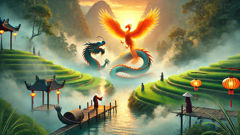
Qilin, Tortoise, and the Binding of Balance
If the Dragon and Phoenix taught endurance and transformation, the Qilin and Tortoise taught temperance and memory—the quieter, steadier virtues that stitch a community together across generations. The Qilin is often described with a gentle absurdity: the head of a deer, the scales of a fish, hooves that do not bruise grass, a mane like woven silk, and a breath scented of sandalwood and green leaves. In the village’s telling, the Qilin arrived when parents felt confusion about raising children in a changing world—when new trade routes brought strangers and stories that made elders uneasy. The Qilin offered a promise: moderation and just action. It did not reward excess nor tolerate cruelty. In the most popular village parable, a merchant sought to trick a farmer by falsely inflating the weight of his rice, taking coin for a bag lighter than promised. The Qilin appeared not as thunder but as an awkwardly beautiful sentinel in the marketplace. When the merchant, proud of his cunning, tried to leave with ill-gotten riches, he found his cart too heavy to move and his tongue stubbornly tied. Each dishonest coin felt like a stone in his pocket. Only when he returned to the farmer and apologized, reweighing and paying the honest price, did the Qilin allow his passage. From then on, the villagers taught children that greed makes travel hard in strange and comical ways. The Qilin’s lessons were enforced by little laws that grew into village custom: no false measures in the market, no cheating at harvest share-outs, and a public ritual of confession and repair if wrongs were done. These social practices preserved trust—the Qilin’s invisible contribution to the village’s daily economy of kindness. The Tortoise, older than memory, carried a different sort of magic. Where the Dragon wrote the river’s music and the Phoenix sang of renewal, the Tortoise kept the ledger of time. Its shell, in legend, was a map of seasons, a lattice of tiny valleys representing each year’s flood and harvest. A village elder, consulting a Tortoise shell, could foresee when to plant and when to mend roofs; the Tortoise’s quiet guidance was never for sudden gain but for long survival. Stories say the Tortoise spoke in slow, patient parables, comparing life to the slow growth of the banyan tree: roots found where there is forgiveness and shade built by shared labor. Local stone inscriptions bear the Tortoise’s mark—etchings of a spiral shell at shrines where villagers placed offerings for longevity and communal health. The Tortoise also acted as a judicial symbol. If neighbors could not resolve a boundary dispute, they would present their claims at the temple where a carved Tortoise presided. Elders would consider the claims as if consulting the slow breath of the creature, favoring precedent, fairness, and compassion. Over time, these rituals coalesced into a philosophy: short gains harm the soil of trust; patience and measured acts are the true long-term fortune. The four animals’ roles overlapped like woven rice stalks. The Dragon’s gift of abundance was strongest when the Tortoise’s maps were followed; the Phoenix’s renewal spark was sustained by the Qilin’s insistence that rebirth must be rooted in justice. A central village myth ties them together in a single night of test and promise. The rivers rose higher than any living memory. Clouds came like a flock of black birds, the rice fields blurred into water, and houses floated like trapped lanterns. The villagers, terrified, fled to the communal house built on stilts near the temple, where elder and younger huddled with incense and offerings. In their most desperate hour, the four animals came in a halo of different elements: the Dragon surfaced from the swollen river to draw a deep channel that bore the worst of the flood a safe distance from homes; the Phoenix circled above in the lightning-torn sky, dropping embers that landed as faint, warm beacons on rooftops—each ember a promise that those who sheltered others would be sheltered in return; the Qilin padded along the water’s edge, rebuking those who sought to hoard food and guiding them to share stores with the weakest; and the Tortoise, immovable, sank part of its shell into the soil, creating a raised bed upon which the old and sick could shelter until the water went down. The story’s moral was clear: each creature’s virtue alone would not have saved the village. The Dragon’s power without the Qilin’s fairness would have led to unequal survival; the Phoenix’s renewal without the Tortoise’s memory might have birthed chaos. It was the binding of virtues—endurance, transformation, justice, and patience—that preserved the community. That night was commemorated each year by the Festival of Four Lights, a ceremony where the village sets four lanterns at the cardinal points of the communal house—blue for the Dragon, red for the Phoenix, green for the Qilin, and earthy brown for the Tortoise. Young couples ask for blessings there, elders recite the parable of balance, and children march with paper animals tied to sticks. The rituals are practical, too. The festival schedules communal checks on embankments, shares rice stores openly, and records disputes in a public ledger—living customs that trace directly to the lessons of the four animals. Over centuries, these myths affected more than ceremonies. They shaped architecture—temple roofs carved with scaled patterns for the Dragon, phoenix motifs painted on doorframes, qilin statues flanking marketplace gates, and stone tortoises holding stelae. They influenced naming—boats called Thanh Long (Azure Dragon), houses named Kim Phoeng (Golden Phoenix), and even surnames and given names reflecting virtues. The animals entered the language of governance subtly: a fair magistrate was called "qilin-hearted," while communal resilience was praised as "tortoise-slow and dragon-strong." Beyond the village, merchants who learned the virtues found them useful in trade; diplomats found metaphors for balanced treaties. But perhaps the most enduring effect was not in buildings or language but in the quiet, daily agreements that allowed strangers to become neighbors. The legend teaches that protection and fortune are sustained by practice—by rituals and by the steady, repeated actions of ordinary people. By enacting the virtues the animals embodied, the villagers made sacred symbols into living rules. In doing so, they kept the animals from living only in memory, letting them continue as active guardians who attended births, presided at funerals, and accompanied harvests in the form of songs and carvings that seamed the community together like stitchwork on a worn cloth.
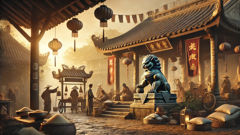
Conclusion
Centuries of telling have not diminished the story’s usefulness; if anything, time polished its edges until the animals’ virtues gleam where they touch human hands. In the modern village, motorcycles and mobile phones hum beside lacquered boats, and yet when a storm approaches the elders still check the Tortoise’s calendar, mothers still light a small bowl of rice at dawn for the Phoenix, and fishermen whisper thanks for the Dragon’s safe passage before they untie their nets. The legend of the four auspicious animals remains more than a collection of fanciful characters: it is a practical ethics, a weather map for moral decision-making, and a cultural scaffold that withstands the push of new things. To live with these animals is to accept that fortune is neither singular nor permanent, that protection must be practiced and shared, and that the dignity of small acts—repairing a roof, restoring a ledger, returning a borrowed pot—accumulates into sheltering wisdom. When visitors ask why the villagers still carve tiny scales into doorposts, why they still perform the Festival of Four Lights, the answer is not merely superstition. It is a story of reciprocity: give care and care will return, be fair and fairness will stand, keep memory and memory will guide. In that answer lies a promise, soft as river mist and bright as phoenix flame: the world’s favor is not a thing taken, but a garden cultivated. The Dragon, Phoenix, Qilin, and Tortoise remain, in song and practice, the garden’s gardeners—each attending their row so that all may eat, each keeping watch so that all may sleep. And when new generations grow up under that promise, they learn that auspiciousness is not a talisman but a habit, a covenant of ordinary kindness that turns a fragile cluster of homes into a community that can weather flood and famine alike. In honoring the animals through ritual and daily care, the people do more than remember—they continue the work of being worthy custodians of the land and of one another.


